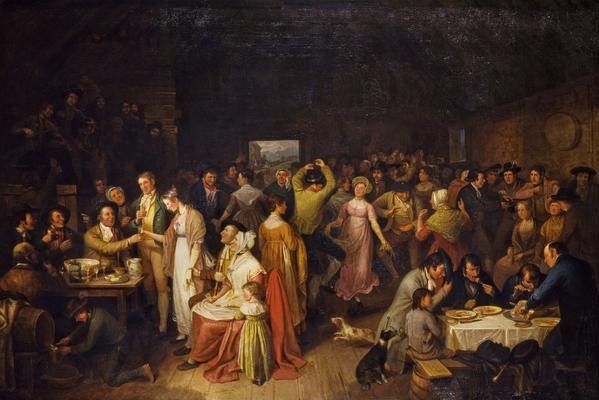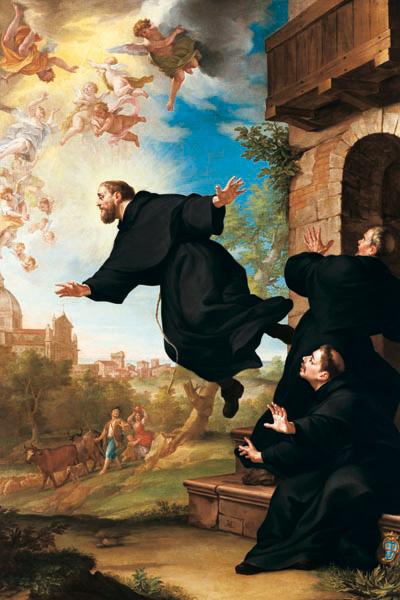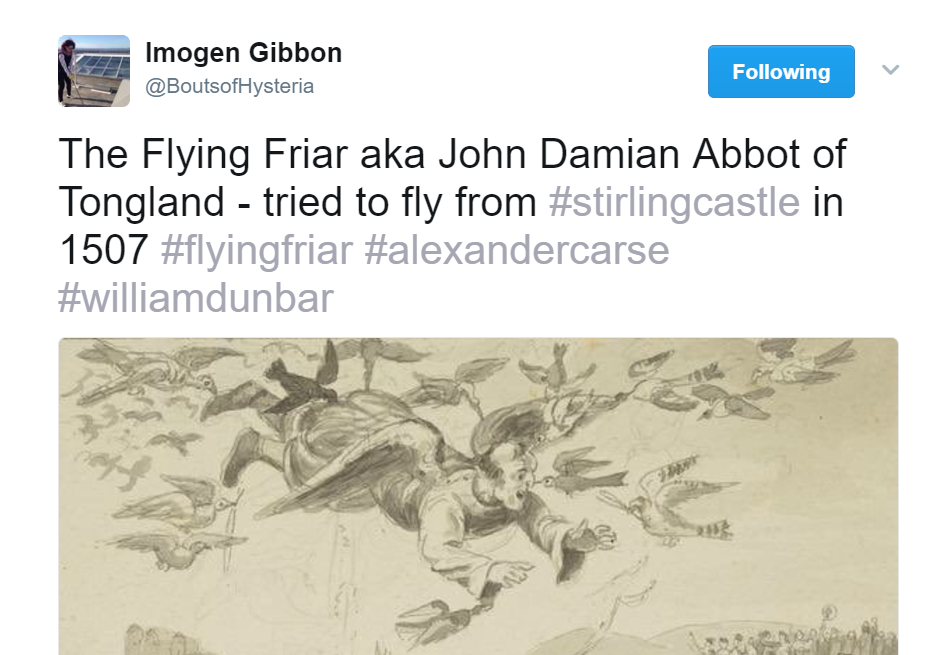One of the most enjoyable parts I found when working in digitisation is the little discoveries of weird and wonderful material that you come across in the green boxes of the print rooms. I have a huge personal list of prints, drawings, sketches and photographs that still make me smile, chuckle and ask “WTF?”. However, after a little bit of library sleuthing, Scots translating (and most importantly a curator with answers), I can now talk about the story behind this rather amusing drawing that went under the camera in 2015 and has captivated me ever since (you can see a high res, zoomable version on the National Galleries of Scotland website:

Alexander Carse, The Flying Friar, Date Unknown. Image credit: National Galleries Scotland. CC-BY-NC
Wonderful isn’t it? A cross between a Hitchcock film with surrealist undertones and a Red Bull advert for the 19th century, it’s a shame it hasn’t been seen more often - I’d love a postcard of it on my desk. At first, my colleagues and I had no idea what to make of it. Who was the man; and what did the birds have against him?
The collections database wasn’t able to shed a lot of light (this is common in museum collections, as there aren’t enough museum staff in the world to fully research and catalogue all of the things). We did, however, get the name of the artist who created the drawing and there is quite a bit on him, as a Scottish artist of note in the late 18th and early 19th century - many genre scenes in the Dutch style but no-one was taking to the skies in them.

Alexander Carse, The Penny Wedding, About 1819. Image credit: National Galleries Scotland. CC-BY-NC.
We weren’t getting very far with the title of the drawing either; the only Flying Friar that was coming to the fore from our extensive research (read: quick fire Googling between photographing the other works in the Print Room) being St Joseph of Cupertino. He was a Franciscan who was reputed to levitate during Mass, and the patron saint of air travellers, astronauts and poor students.

Ludovico Mazzanti, St Joseph of Cupertino in flight at the Basilica of Loreto, 18th Century. Image Public Domain, via Wikimedia Commons
Joseph seemed like a pretty unlikely candidate for the subject - other depictions of him just didn’t appear to fit with the drawing, and he didn’t have any bird related issues. So, the friar remained nameless, popping up throughout the project, our go-to image for showcasing the joyous nuggets that you can find in museum print rooms. Cut to present day; the Flying Friar once again makes an appearance on my timeline. This time, however, PG curator and deputy director Imogen Gibbon had been on the case, and at long last, his identity was revealed to me:

Screen grab of Imogen’s tweet
It turns out I’d been looking much further afield than I should have been, not to mention in the wrong century. The Flying Friar depicts no other than John Damian, notorious alchemist, medicine man and courtier in the court of James IV of Scotland. Damian’s best remembered though as Stirling’s very own birdman; attempting to fly to France from the ramparts of the castle in 1507. Suffice to say, his plan didn’t quite work out, resulting instead in a broken leg and likely a rather bruised ego. Given the height of the fall, its a miracle this was all he suffered.
Adding insult to injury, his rather unfortunate escapade was immortalised in verse by William Dunbar, in his comic Ballat of the Fenyeit Frier of Tungland, How He Fell in the Myre Fleand to Turkiland. Luckily for us (maybe not for Damian), the poem has survived the ages by its inclusion in the Bannatyne Manuscript, a 16th-century Scots literary anthology, now preserved in the National Library of Scotland. Numerous transcriptions of the manuscript were published since, many of which are now digitised, making it relatively easy work to find a copy of Dunbar’s comedy verse to read for myself.
Reading the poem, it seems that Dunbar REALLY had it in for Damian, the work alluding to many allegations made against him in the court at Stirling - that he was a charlatan, murderer, terrible doctor (known to kill a few patients), and in the below passage a false priest; who neglected his religious duty for the many alchemy projects funded by James.
Unto no Mes pressit this prelat,
For sound of sacring bell nor skellat,
As blaksmyth bruikit was his pallatt,
For battering at the study
John Damian, Ballat of the Fenyeit Frier of Tungland
For the purpose of this post though, we’re more interested in the verses about Damians attempt to fly. Here, Dunbar adds a delightful flourish of fantasy to the friar’s fate; having him attacked by many different species of bird, in ever creative ways:
The tarsall gaif him tug for tug,
A stanchell hang in ilka lug,
The pyot furth his pennis did rug,
The stork straik ay but stynt,
The bissart, bissy but rebuik,
Scho was so cleverus of hir cluik
His bawis he micht not langer bruik,
Scho held thame at ane hint.
Before finally crashing into a midden underneath the castle.
He schewre his feddreme that was schene, And slippit out of it full clene, And in a myre up to the ene. Amang the glar did glyd.
Preserved in the Bannatyne manuscript, the poem passed down the generations and into the wider literary circles of Scotland. Carse, known to make drawings of ‘poetical subjects’ must have felt that a tale such as Dunbar’s satirical piece merited an artistic response, sketching out this drawing detailing the scene just before John Damian’s tumble to earth. So there you have it, mystery solved! (although maybe not in John Damian’s favour..)
I like to think there are a couple of lessons to this story. Firstly be really, really careful not to upset poets - you might end up immortalised for the ages in a less than flattering light. Secondly (and most importantly), no amount of Googling will ever replace some well-applied research; a lesson many people could learn from I’m sure (myself included). Finally, there are so many unshared stories about museum objects which deserve to be shared with the world; and the opportunity to help do so is one of the most rewarding aspects of my job.